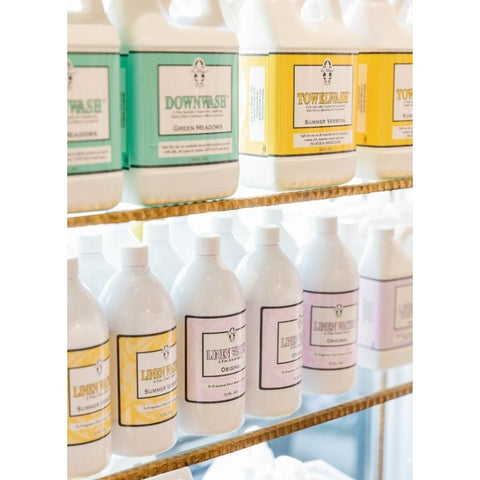The Care and Keeping of Luxury Linens – Expert Tips on Laundering
Finding the perfect linens for your home can be both time consuming and expensive. You will consider it time and money well spent, though when you slip into your luxuriously appointed bed each night.
To keep your sheets looking and feeling as fabulous as they did the day you purchased them, you’ll need to take extra care in laundering and storing them in between use.
Ready to take those gorgeous new linens out of the package? Here’s what you need to do first…
Fine fabrics are generally not pre-washed, so good quality linens should always be washed before use. This first wash is important for setting the threads, which will preserve the fabric’s beauty and prolong its life.
When washing your linens, make sure to follow these rules carefully:
- Set the machine to wash in warm (NOT hot) water on a gentle or delicate cycle with a cold water rinse.
- Use a mild detergent that does not contain any bleaching agents such as chlorine or peroxide. Chlorine bleach can weaken natural fibers and may cause them to yellow. If necessary, use an oxygen-based bleach. We recommend LeBlanc Linen Wash.
- Never pour the detergent directly onto fabric. Instead, add your fully unfolded linens to the tub after it fills and the detergent has already been diluted in the water. Fine linens only require half the recommended amount of detergent, but you can add more in future washing if the fabric is very soiled.
- Never use fabric softeners. They make fibers appear soft by coating them, but ultimately cause damage over time. Your luxury linens will soften naturally with frequent use and additional washings.
- Wash matching linens (like sheets and pillowcases) together. Each piece should be cared for similarly regardless of whether or not it is soiled to help maintain color consistency and brightness.
- Always avoid overloading the washer to prevent fiber breakdown from excessive abrasion and agitation. It helps to wash one queen or king sheet at a time with smaller items, such as pillowcases.

Washing embroidered linens? These are particularly delicate and should be washed separately. You can also add salt to the water to prevent the loss of embroidery thread color or “running” of dyes. Are your linens silk? These may be dry cleaned, hand washed or machine washed on a gentle cycle, so it’s best to check cleaning instructions provided by the manufacturer.
Some choose to dry clean “top of the bed” items like duvet covers, coverlets, and shams, but many can be safely washed at home. For the latter, be sure to use warm or cold water and a delicate cycle.
For future laundering of all linens, make sure to pre-treat stains with a quality product and separate whites from colors (we all know that white + red = pink!). Also, separate your fine linens from products like towels or items containing polyester or other synthetics to avoid pilling and abrasion. Anything with metal buttons, zippers, etc. should be put in a different cycle, as they can cause damage to more delicate fabrics.
You can find a full listing of Bedside Manor’s preferred fine cleaning products HERE.
Now it’s time to move everything to the dryer! Or not…
It goes without saying that line drying linens in soft, outdoor sunlight is ideal. It is the most gentle, and the sun provides natural bleaching. Since this is not always practical, you also have the option of air drying on a rack or a large surface (like a bed) instead.
Still looking at us like we’re totally nuts? Okay – it IS possible to put linens in the dryer without completely ruining them. But you do need to take far more care with them than you do with your socks and gym shorts! Hot dryers weaken and damage the fibers in fine linens. Heat also causes shrinkage, resulting in ill-fitting sheets, which further stresses the fabric. This can cause holes, rips or pilling. So “gentle” is the way to go. Here are some tips for gentle machine drying:
- Carefully shake out and smooth damp linens before placing them in the dryer. Make sure to unravel any items that may have twisted in the wash cycle.
- Never wring out wet linens. This will cause wrinkling and may weaken the fibers. If it’s necessary to soak up extra moisture, try rolling the item in a towel.
- Never use dryer sheets with any fine linens. They coat and weaken natural fibers just like liquid fabric softeners.
- Avoid overloading the dryer so items will dry evenly. You can also dry fitted sheets and duvet covers separately so that pillowcases and other small items won’t get “balled up” inside those them where they’re less likely to dry thoroughly.
- Set your dryer to the lowest heat.
- Remove items from the dryer promptly and while still slightly damp. Then smooth and let them air dry for a bit by hanging or lying flat before folding.
You can also press slightly damp linens with an iron to remove any remaining wrinkles. If you do choose to iron, always press the reverse side of the fabric. For cotton, use a hot steam setting; and for linen, use a hot setting combined with a water spritzer. Iron damask on the reverse side first, then on the front side to bring out the sheen. For embroidered, lace or monogrammed linens, iron on the reverse side on top of a terry towel to protect the embellishment.
Now that everything is crisp and dry, you are ready to fold!